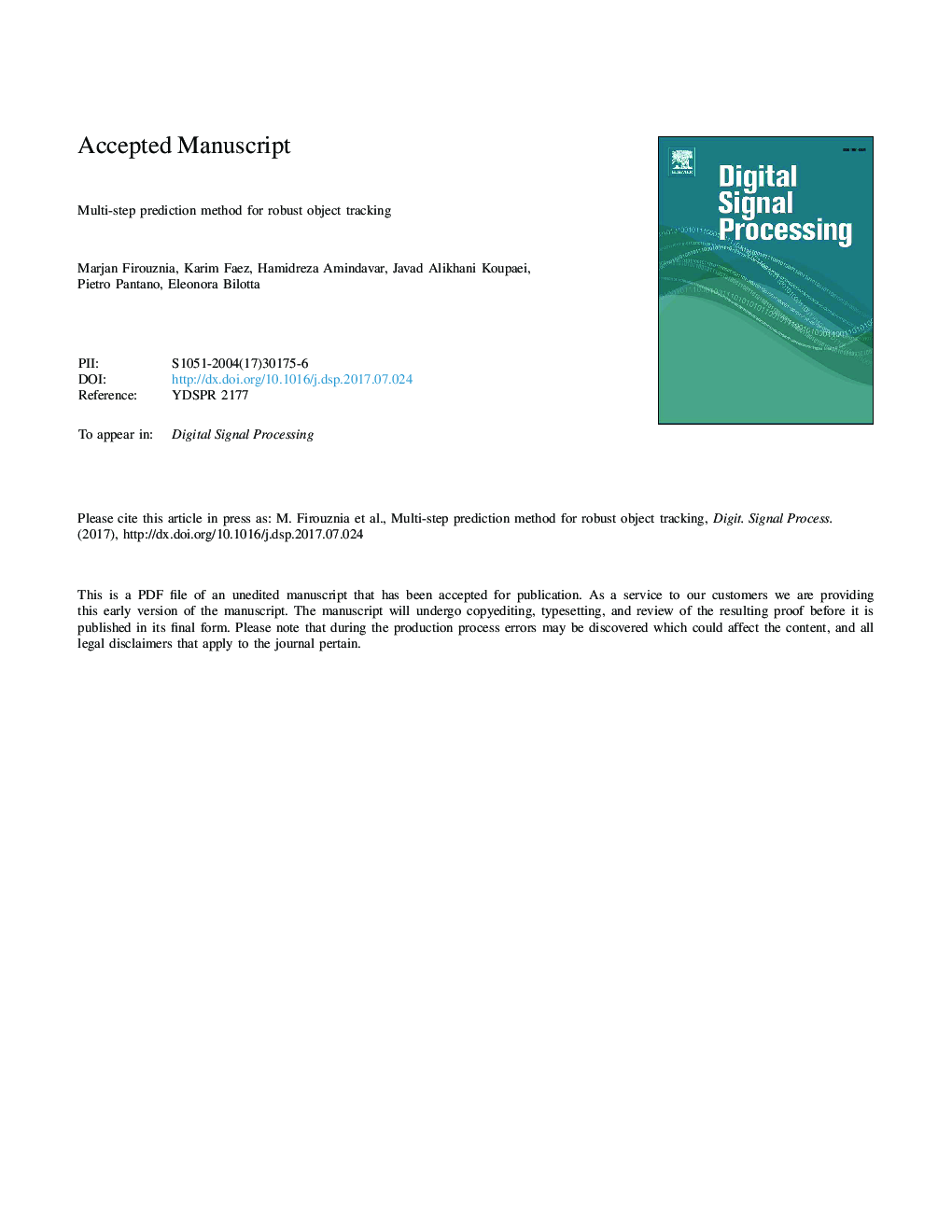| کد مقاله | کد نشریه | سال انتشار | مقاله انگلیسی | نسخه تمام متن |
|---|---|---|---|---|
| 4973764 | 1451710 | 2017 | 26 صفحه PDF | دانلود رایگان |
عنوان انگلیسی مقاله ISI
Multi-step prediction method for robust object tracking
ترجمه فارسی عنوان
روش پیش بینی چند مرحله ای برای ردیابی دقیق جسم
دانلود مقاله + سفارش ترجمه
دانلود مقاله ISI انگلیسی
رایگان برای ایرانیان
کلمات کلیدی
نظریه هرج و مرج، ردیابی شی، پیش بینی چند مرحله ای پیش رو، به دست آوردن داده های شبیه ساز مدار، وقوع،
ترجمه چکیده
در این مقاله روش پیش بینی چند مرحله ای پیش رو برای ردیابی شیء بر اساس نظریه هرج و مرج معرفی شده است. نظریه هرج و مرج برای حفظ اطلاعات حرکت جسم و مدل عدم قطعیت و غیر خطی حرکت در توالی ویدیو استفاده می شود. روش الگوریتم شامل سه مرحله است. اول، با استفاده از حالتهای قبلی شیء، برای به دست آوردن حالت بعدی، برای برآورد وضعیت بعدی، تطبیق داده می شود. دوم، اعضای این گروه از دولت برای پیش بینی پیش بینی های چند مرحلهای پیش بینی شده اند. سپس، تابع احتمال از اعضا، پچ کاندید را برای تشخیص هدف با استفاده از اطلاعات رنگ انتخاب می کند. این الگوریتم به علت اطلاعات پویای بالا از پیش بینی حرکت و هرج و مرج به طور قابل توجهی خطا پیش بینی را کاهش می دهد. برای بررسی کارایی ردیاب، الگوریتم ردیابی با روش های تصادفی و قطعی در دو مجموعه داده مقایسه می شود. نتایج نشان می دهد که ردیاب مبتنی بر هرج و مرج با سایر روش های پیشرفته ترین در حرکت ناگهانی، اکلوژن و خارج از دید بهتر عمل می کند. الگوریتم حدود دو برابر سریعتر از روش فیلتر ذرات است، در حالی که خطای فیلتر ذرات حدود دو برابر بیشتر از خطای روش ردیابی مبتنی بر هرج و مرج است.
موضوعات مرتبط
مهندسی و علوم پایه
مهندسی کامپیوتر
پردازش سیگنال
چکیده انگلیسی
In this paper, multi-step ahead prediction method for object tracking based on chaos theory is introduced. The chaos theory is used to preserve the information of object's movement and to model uncertainty and nonlinearity of movement in video sequences. The methodology of the algorithm includes three steps. First, adaptive pseudo-orbit data assimilation is applied to estimate the next state by using the previous states of object. Second, the ensemble members of the state are generated to predict multi-step prediction. Then, the likelihood function of members selects candidate patch for target detection using color information. The algorithm significantly reduces the prediction error because of high-order dynamical information of motion and chaotic prediction. To verify the efficiency of the tracker, the tracking algorithm is compared with the stochastic and deterministic methods under two datasets. The results demonstrate that the chaotic-based tracker outperforms other state-of-the-art methods on the abrupt motion, occlusion, and out of view. The algorithm is about two times faster than the particle filter method while the error of particle filter is about two times more than the error of the chaotic-based tracking method.
ناشر
Database: Elsevier - ScienceDirect (ساینس دایرکت)
Journal: Digital Signal Processing - Volume 70, November 2017, Pages 94-104
Journal: Digital Signal Processing - Volume 70, November 2017, Pages 94-104
نویسندگان
Marjan Firouznia, Karim Faez, Hamidreza Amindavar, Javad Alikhani Koupaei, Pietro Pantano, Eleonora Bilotta,
